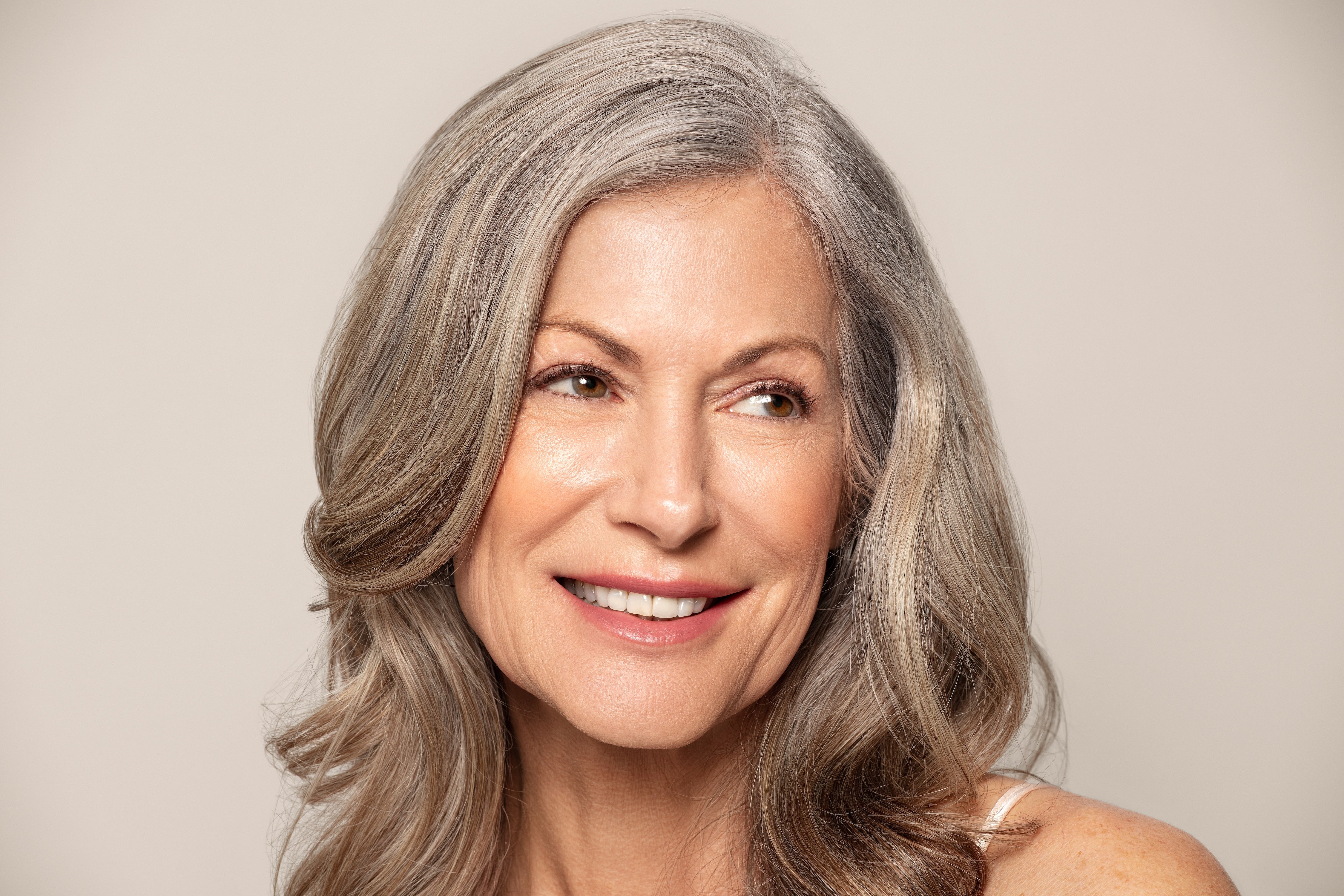When your hormones change, your skin changes too. To keep your complexion healthy and vibrant during menopause, focus on skincare that hydrates, renews skin cells, and brightens with all-natural ingredients.
The beautiful thing about women’s bodies is, we’re meant to adapt. Through puberty, fertility, pregnancy, postpartum, and menopause, our bodies change with the seasons of life — and that’s a good thing. It’s something we should embrace.
One of those life stages, menopause, begins the year after your last period. But before that, you may experience perimenopause, the transitional stage when your period (and hormones) are somewhat in flux. As your body closes its fertility window, it shifts how your primary hormones function. During this shift, estrogen and progesterone levels drop, which can impact a lot of things, including your skin health.
This is incredibly common, and most women change their skincare routine entirely during menopause. If you’re noticing dry skin, sensitivity, hormonal acne, and sun damage, you’re not alone. Here are some ways to resolve these concerns using skincare for menopause.
Does Menopause Change Your Skin?
The short answer is yes. Shifts in hormone levels don’t just impact energy. Women notice changes in skin barrier and sebum production, too. When estrogen drops, the skin barrier may become more sensitive and prone to breakouts. Dry skin and signs of aging are also common, as collagen production lessens.
During menopause, many women change their skincare routine entirely. Potent products take center stage to address dry skin, sensitivity, and signs of aging. And former beauty staples are often set aside as skin becomes more sensitive.
How to Address Common Skin Concerns During Menopause
Sun damage or age spots
In menopause, the skin is a bit less resilient. Sunburns happen easily, and so do sun spots. One thing to keep in mind here is that less resilient often means undernourished. Many of the common symptoms of menopause resolve when your body is given the proper tools.
-
Why Does It Happen?
A weakened skin barrier is less resilient to sun exposure.
-
How to Resolve Sun Spots
Give your skin nutrients to support hormone shifts. Eat collagen-rich foods and apply targeted botanicals directly to sun spots.
-
Ingredients We Recommend
Helichrysum oil, tallow balm (for vitamin A), AHA fruit acids, bakuchiol, beta-carotene, and topical vitamin C.
Dry skin
Even for women who had oily skin in their teens and twenties, dry skin during menopause can come on suddenly. You may notice overall dryness or uncomfortable dry patches. Fluctuating between oily and dry skin is common, too.
-
Why Does It Happen?
Typically, it’s caused by low estrogen levels.
-
How to Resolve Dry Skin
Use oil to cleanse your skin and follow up with a nutrient-dense moisturizer. These products work to rebuild the skin barrier externally and stand in the gap while your hormones rebalance. Drink plenty of electrolytes and eat collagen-boosting foods, like gelatin gummies.
-
Ingredients We Recommend
Jojoba oil, seabuckthorn oil, tallow balm, emu oil, aloe vera, and castor oil.
Hormonal acne
Pimples on your cheeks and jawline can indicate hormonal acne, but a telltale sign is when it happens during menopause. You probably won’t experience the same kind of acne you had as a teenager, but hormonal acne during menopause can be more painful, since your skin is thinner.
-
Why Does It Happen?
Changes in estrogen, progesterone, and testosterone impact how your skin regulates oil production.
-
How to Resolve Hormonal Acne
Correct hormone imbalances with nutrition support. For skincare, use a nontoxic tonic and oil cleanser to address breakouts gently. Be careful with modern cleansers, since many of them are harsh.
-
Ingredients We Recommend
Tallow, emu oil, beeswax, seabuckthorn oil, frankincense, cajeput, basil, and hibiscus.
Sensitive skin
Highly sensitive skin is a common side effect of menopause. You may notice you burn more easily in the sun, and your go-to skincare products are suddenly prompting a rash. This isn’t abnormal, and a change in skincare strategy usually resolves it.
-
Why Does It Happen?
Thinner skin, changes in pH levels, and reduced collagen production.
-
How to Resolve Sensitive Skin
Use deeply nourishing and moisturizing products that last all day. Natural ingredients are a must in menopause, since harmful chemicals tend to irritate the skin.
-
Ingredients We Recommend
Helichrysum oil, seabuckthorn oil, frankincense, 100% grass-fed tallow, chamomile, raw honey, and bakuchiol (as a retinol alternative).
Poor wound healing
With thinner skin and lower nutrient availability, you may notice poor wound healing during menopause. This is a common sign of aging and isn’t something you should stress over. Just have the right products on hand in case you get a cut, scrape, or pimple.
-
Why Does It Happen?
Fewer available nutrients, lower estrogen, and higher inflammation.
-
How to Accelerate Wound Healing
Tallow balm is our go-to, since the nutrients in tallow are almost bioidentical to those found in human sebum. If your skin isn’t healing well on its own, tallow balm provides essential nutrients while reducing inflammation with CLA.
-
Ingredients We Recommend
Tallow balm, emu oil, beeswax, helichrysum oil, and vitamin C.
Fine lines and wrinkles
No, you’re not just imagining it. Menopause can make your skin age faster because of the way hormone levels change. You may also notice that drier skin leads to wrinkles and fine lines (although these may not be permanent).
-
Why Does It Happen?
Dehydration, dry skin, and hormonal changes.
-
How to Resolve Fine Lines and Wrinkles
Start with intentional hydration from the inside out. Use minerals, electrolytes, and skin-building foods. Then apply targeted nutrients twice a day during your skincare routine, and plump your skin with regular gua sha practice. You can use face tape and facial yoga, too.
-
Ingredients We Recommend
Bakuchiol (nature’s retinol), vitamin C, helichrysum, tallow, beta-carotene, aloe vera, AHA fruit acids, castor oil, jojoba oil, and seabuckthorn oil.
3-Step Skincare Routine for Menopause
-
Cleanse with oil
Your cleanser isn’t just for removing dirt, impurities, and makeup anymore. Now, you need something that will hydrate and restore balance as hormones fluctuate. An oil cleanser works with the natural oils of your skin, helping them stabilize. Unlike a harsh cleanser, this shouldn’t disrupt the skin barrier or cause sensitivity or breakouts. But it should help resolve hormonal acne and dry patches.
-
How to Oil Cleanse: Choose a nourishing oil cleanser with natural ingredients. Start with a dime-sized amount and massage it into your face for about 5 minutes. When finished, wipe off the oil with a wet cotton cloth.
-
Target with a serum
Your serum is your ultimate skincare customization formula. Any skin concerns you have (dry skin, eczema, sensitivity, hormonal acne, etc.) should be addressed by the ingredients in your serum. If you’re still dealing with active symptoms, this is a sign to either change your serum or add one to your routine. Make sure you check the packaging, too. You want potent natural ingredients to be at the top of the label, with no synthetic chemical dilutions or fragrance.
-
How to Use a Serum: After cleansing, apply 3–10 drops of serum (depending on the instructions) directly to your face. Pat in the serum with your hands or with a tool until it’s properly absorbed.
-
Moisturize with nutrients
A good moisturizer doesn’t just soften the skin; it delivers compounds that rebuild cells and sebum. Think about it this way: menopause (and the loss of nutrients to your skin) is an opportunity to see your moisturizer really do its job. Grass-fed tallow balm is our go-to, since it’s nearly bioidentical to the skin. Nutrients that are lost during menopause can easily be replaced with topical tallow balm or the right herbal skincare.
-
How to Moisturize: With tallow balm, less is more. You’re not slugging your skin. You’re giving it nutrients to gently absorb. Start with a pea-sized amount and gently massage it into your face. If more is needed, add a little bit at a time.
Common Skincare Mistakes to Avoid During Menopause
Not using skincare on your neck and chest
It’s not required to use skincare products on your neck and chest. But it may help to know that these areas do show signs of aging, and the skin may become more sensitive as you age. If you’re using anti-aging skincare on your face, it’s best to cover your neck, too.
Using harmful chemicals on your skin
Synthetic chemicals have no place in your skincare for menopause. Hormonal shifts are easily exacerbated by the endocrine disruptors found in most body and household products. If you wouldn’t let your teenage daughter use them during puberty, you shouldn’t use them in menopause.
Over-exfoliating
Exfoliating is helpful for reducing age spots and balancing uneven skin. But when your skin is sensitive or rapidly changing, too much exfoliation can damage the skin barrier. Start with a gentle exfoliant (AHA fruit acids or a facial dry brush) just once a week. Work your way up to twice a week if your skin still looks and feels vibrant. Once or twice a week is really the maximum recommended amount of exfoliation for mature skin.
Ignoring collagen-boosting foods
Collagen is responsible for bouncy skin. It’s the nutrient that hydrates and increases elasticity, which leads to fewer wrinkles and dehydration lines. But as we age, collagen levels drop. We should apply collagen-building ingredients to our skin, but we need to address this issue via diet, too. Skin-building foods like gelatin, collagen, antioxidant-rich fruits and veggies, grass-fed meats, and electrolytes allow us to target the problem from the inside.
Your Skin Deserves Safe Care
If you’re in menopause, you’ve probably spent a great deal of your life caring for other people. You also probably grew up during a time when people didn’t read ingredient labels to make sure they were hormone-safe. As your skincare routine changes, take this as your opportunity to really think about the best way to nourish your long-term health. You deserve hormone-safe ingredients, too, and you deserve skincare products that genuinely make you feel like the best version of yourself.

